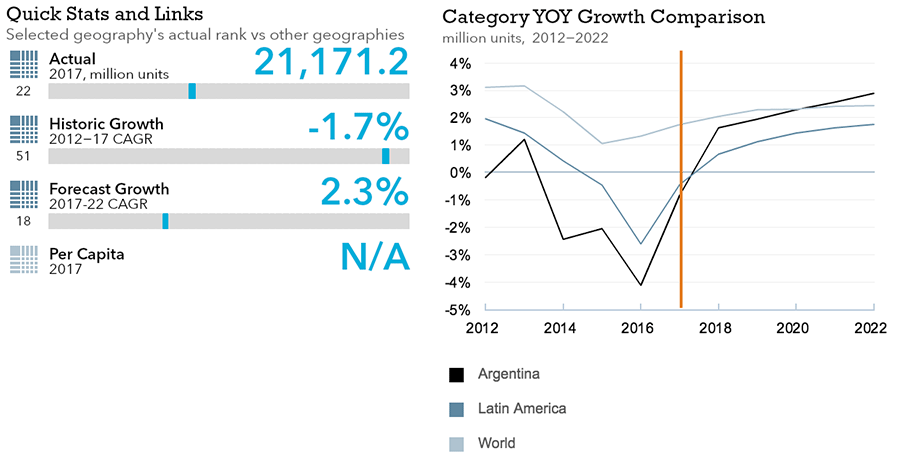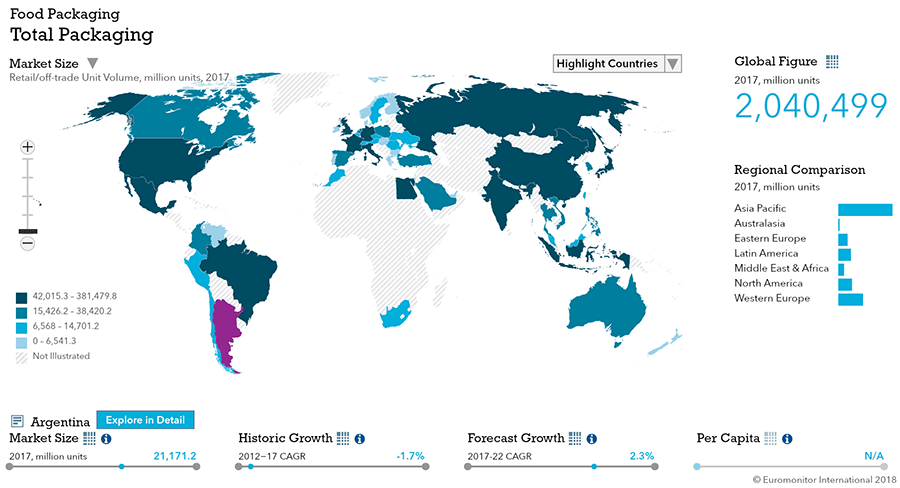Flexible Packaging Landscape

- In 2016 total dairy packaging sales decrease by 1% in retail volume.
- Falling demand for drinking yoghurt sees HDPE bottles decline by 8% in retail unit volume terms in 2016.
Trends
- In 2015, for the first time since 2008, there is a pack size of over one litre in milk in Argentina. RPB launched shelf stable milk in 1.5-litre brick liquid cartons with liquid carton closures.
- High inflation led consumers to acquire milk in brick liquid cartons. They stocked up on milk in brick liquid cartons at the expense of flexible plastic, which, despite being a more economical option, has very fast expiration. As a result, brick liquid cartons increased considerably, accounting for a 50% share of total units sold in milk in 2016, followed by flexible plastic with 48% and HDPE bottles with 2%.
- 125g thin wall plastic containers made a strong entrance in fruited yogurt in 2015, accounting for a 16% share of sold units of fruited yogurt in 2016.
- Glass jars registered the worst performance in dairy packaging with a 12% decrease in retail unit volume sales in 2016. This pack type is used mainly for spoonable yogurt, which is dominated by thin wall plastic containers.
- Multipacks in dairy packaging could not reverse a downward sales trend, registering a drop of 7% in retail unit volume terms to reach 404 million units in 2016. This decrease was mainly due to the lower consumption of flavored yoghurt and probiotic drinking yogurt.
Outlook
- Following RPB’s launch of 1.5-litre brick liquid cartons in shelf stable milk, many companies are interested in adopting pack types of more than one litre in drinking milk products. The intention is to offer consumers a cheaper alternative in per litre terms. Consequently, in the short term, new pack types and sizes are anticipated in drinking yoghurt, fresh milk and shelf stable milk.
- Flexible plastic is expected to lose further ground in milk and drinking yoghurt to liquid cartons over the forecast period. With the recovery of the national economy and, therefore, consumer purchasing power, liquid cartons isperceived to offer advantages in terms of practicality and closures.
- Shaped liquid cartons is expected to post the fastest retail volume CAGR of 12% over the forecast period to reach 85 million units in 2021. This growth will be driven by two product types. Firstly, drinking yogurt, and secondly, soy drinks.
- Over the forecast period, liquid carton closures offers strong growth potential due to its recent adoption by leading brands.
- Tetra Pak is expected to remain the sole supplier of liquid cartons in dairy in the medium term in Argentina.
Disclaimer
This database attempts to compile data from numerous sources. Users should be aware that because different sources are used, there could be errors or omissions. The user accepts that the information is only intended to be an initial reference. The user understands that there is no assurance that this reference material is error free, and that no one involved in compiling or distributing this reference material shall be liable for any damages arising out of its use. Commercially important information should be rechecked and verified with knowledgeable parties in the country of interest.

